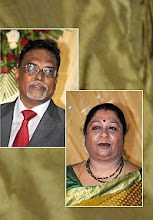COOKING MADE EASY: B. Ramakrishnan.(One page, countless choices )
SHONALI MUTHALALY

Food blogger Ramki’s one-page cookbooks deconstruct traditional Indian cooking. SHONALI MUTHALALY joins him in the kitchen to whip up an unconventional meal
It all began when I lost a bet. Food blogger B. Ramakrishnan aka Ramki challenged me to cook a traditional South Indian 10-item meal in half an hour. So, of course, all my supportive friends and family laughed themselves into knots.
Fortunately Ramki had a plan. Author of the intriguing ‘one page cookbooks’ (http://ramkicooks.blogspot.com/) he worked out a menu based on these cheat sheets, breaking recipes into building blocks.
The rasam collection, for instance, enables you to make 1,001 varieties of rasams by following a master recipe, and combining boxes. Column one has nine bases, including tamarind, buttermilk and coconut milk. Column two has flavourings, such as pepper, ground spices and fried dal. Then comes Column three with goodies such as garlic, tomato and pineapple. Combine with salt, add rasam powder, and cook.
At Ramki’s restaurant, Streetfoodz in Kodambakkam, he explains why this technique works. “All you have to do in each set of recipes is master one skill... With podis, it’s roasting.” He minimises work by maximising basic flavours. “Traditional podi recipes ask you to take 10 kinds of lentils and roast them separately. The truth is that with one lentil, and the right technique, it will taste beautiful... It’s so bloody easy. There’s no space to go wrong.”
The cookbooks, designed so that they fit into a single printout, are clearly concocted by a mathematical whiz. They use logic to break down complex recipes and extract their essence. Not surprisingly, Ramki’s an MBA in Marketing and Finance from XLRI in Jamshedpur. What is surprising is that he started cooking just 10 years ago.
“I travelled abroad, and found it difficult to get our food,” he says, adding that when he started to cook he found recipe books infuriating. “They treat you like an idiot. It’s almost impossible to duplicate a recipe. There are too many variables involved. It’s far easier to create your own.”
Variety fare
His format leaves plenty of room to manoeuvre, since it concentrates on broad themes. “I was pretty pleased when I discovered it works. It’s so simple. Once you get the big picture right, you can cook a different variation of a theme every time, so you never get bored.”
The basic principal is that every regional cuisine rests on a handful of ingredients. “In Tamil Nadu, it’s tamarind, yoghurt, coconut and tuvar dal. Various combinations yield different results. A kuzhambu, for instance, is made from tamarind water flavoured with red chilli. If you add boiled dal, it becomes sambar. Rasam’s a watery version of the sambar. Kootu is coconut-cumin-chilli with boiled dal.
To create a good meal, you need to understand your ingredients. Take asafoetida. “No temple cuisine uses onion and garlic or chillies. Just like you are not supposed to marry a foreign girl, you are not supposed to use a foreign vegetable.” So, someone discovered that this resin compensates for onion and garlic. Hence, you use it in dishes that don’t contain either.
Quick and healthy
For the record, my cooking turns out to be startlingly delicious, with no major mishaps. (Besides absent-mindedly sticking my finger in my eye after cutting green chillies.) Made with minimal oil and heat, the food is fresh and healthy. Since most of it can be done with just a blender and microwave, it’s also quick.
It’s astonishingly liberating. Traditional food often gives the impression of being complex, exacting and time consuming. Ramki’s method gives you a key to unlock its secrets. On the flip side, since it’s non-conventional; the results are tasty, but also often non-conventional.
Though the method is addictive it doesn’t necessarily don’t work for everyone. Ramki’s mother, for instance. “She refuses to believe that cooking can be easy,” he laughs. “Unless she’s laboured all day, she doesn’t feel it’s a good meal. I do it in 15 minutes, and she enjoys my food, but still doesn’t believe it’s the ‘right’ way to cook.”
(The Hindu , 19:09:2009)
_________________________________
All one page cookbooks work the same way. Choose anything you like from column 1, column 2 and column 3. Cook as per master recipe. That's it! Learn one recipe and you've learnt them all !
1. Complete Indian cuisine in 4 A3 sized posters.
2. Chaat Varieties
3. Easy Podis ( Tamil, English)
4. Muesli
5. Cooking Solo for 500
6. Kitchen virgin survival manuals
7. Rotis
8. Biryani
9. Sambar
10. Simple Pickles
11.Vadam / Vadagam variations
12. Simple Aviyals
13. Kongunadu recipes
14. Instant Dosa varieties
15. Salad Varieties
16. Hotel room cooking
17. Thogayal
18. Pappu
19. Quickie Dinners
20. Quickie Breakfasts
Download the 1001 South Indian Curries eBook
Labels: Liesure


0 Comments:
Post a Comment
<< Home